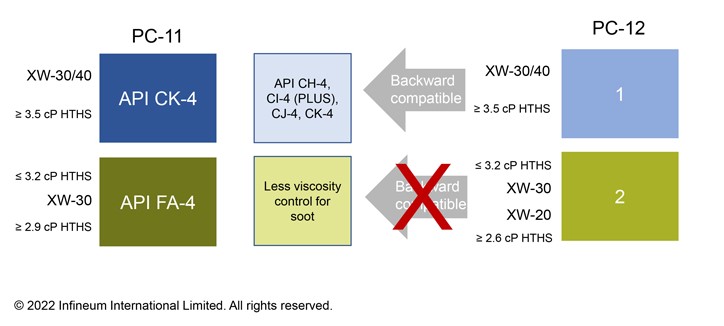Commercial vehicles
ACEA HD Sequences released
22 January 2025
31 March 2022
Collision of emissions requirements drives need for new North American heavy-duty engine oil specification

The need to meet upcoming NOx and greenhouse gas emissions regulations is driving change to heavy-duty diesel hardware. To ensure lubricants continue to deliver sufficient engine and aftertreatment protection, the Truck and Engine Manufacturers Association has requested a new heavy-duty engine oil performance category, PC-12. David Brass, Infineum Lead Industry Liaison Advisor, explores the drivers and looks at the progress being made on the new category development, which is needed for model year 2027 vehicles.
With the control of pollution from heavy-duty vehicles and carbon reduction commitments as the main drivers, emissions regulations in the US are set for significant change in the coming years. Meeting the 2024 greenhouse gas (GHG) and nitrogen oxides (NOx) limits mean only evolutionary improvements to vehicle hardware. But, looking ahead, the tough new limits being proposed for 2027 and 2031 will have a more significant impact.
In March 2022, the US Environmental Protection Agency (EPA) took the first step on its ‘Clean Trucks Plan’. This is a series of clean air and climate regulations that the EPA says it will develop over the next three years to reduce pollution from trucks and buses, starting in model year (MY) 2027, and to advance the transition to a zero-emissions transportation future.
The EPA 'Clean Trucks Plan’ proposal would reduce emissions of NOx from the truck vehicle park by as much as 60% by 2045 and set updated greenhouse gas (GHG) standards for heavy-duty vehicles as soon as model year 2030.
In addition, further action on NOx reduction comes from the California Air Resources Board (CARB) that has set new ultra-low NOx limits to cut emissions by 75% and 90% from the current standard of 0.2 g/bhp-hr in 2024 and 2027 respectively.
These tougher regulations push for reductions in GHG emissions, longer emissions device/engine warranties and longer aftertreatment system useful life. There was also the addition of a low-load NOx test to help reduce emissions of trucks sitting with more idle time on the freeways and local streets. To meet these demands significant engine technology changes will be needed, which in turn will impact lubricant requirements. These changes, along with the desire to move to lower viscosity oils for fuel economy improvement, have prompted the Truck and Engine Manufacturers Association (EMA) to request a new engine oil category development from American Petroleum Institute (API), with a target release date of January 1 2027, ready for use in MY 2027 vehicles.
There has already been activity on the road to developing the new category. API formed the heavy-duty engine oil New Category Evaluation Team (NCET) to further define the needs of the new specification. The team includes three subgroups with different areas of focus:
Subgroup 1 - wear protection and test availability
Subgroup 2 - optimisation, chemical box, and viscosity
Subgroup 3 - oxidation, corrosion, and other remaining topics of interest (e.g. elastomer compatibility, deposits/sludge, aeration/foaming, and coating compatibility/tribofilm formation)
The evaluation phase completed in December 2021 which means industry has now moved into the New Category Development Team (NCDT) Phase of PC-12 where these evaluated decisions will be implemented.
There has been some debate about how the new category might be split and it now appears that PC-12 will bring two new sub-categories to heavy-duty engine oils. These will align with the viscosity divide that we have today with API CK-4 and FA-4, which associates fuel efficiency with the corresponding performance levels.
The first sub-category retains the existing heavy-duty oil criteria of a minimum of 3.5 cP HTHS and will be backward compatible to older categories: API CH-4, CI-4 (PLUS), CJ-4, CK-4. The second lower viscosity category provides fuel efficiency benefits while maintaining durability. This is expected to extend down to 2.6 cP HTHS, enabling the use of SAE XW-20 viscosity grades, and go up to 3.2 cP HTHS to align with the current API FA-4 category. Since its target use is in engines with modern and future aftertreatment systems (containing a selective catalytic reduction (SCR) aftertreatment system) it requires less viscosity control for soot. The second category will not be backward compatible to older categories.

EMA has also requested additional wear performance through the new Ford 6.7L Valvetrain Wear Test and the Detroit Diesel DD13 Scuffing Test; better oxidation performance to help maintain oil drain intervals for hotter engines; and possibly tighter chemical limits to help protect aftertreatment systems, targeting levels of 0.08%m phosphorus and 0.3%m sulphur.
In addition to developing new tests, there is also a need to deal with aging engine tests that are reaching the end of their lives. Here API is assessing the Mack T-11 and Mack T-12 tests and is looking at replacement options for them for PC-12 and for the older API categories.
To enable further reduction in viscosity for GHG improvement the industry needs to understand the capability of the current and new tests to be able to reliably measure the performance of the new lower viscosity SAE XW-20 fluids. With many of the engines being greater than 20 years old they were not designed with these lower viscosities in mind for standard use.
The current API CK-4 and FA-4 engine oils took five years to develop from request to first licensing and will be the most modern categories for 10 years by the release of PC-12. With the investment in time and money required to bring new categories to market we hope that the new categories will also have a reasonable life so that stakeholders have the opportunity to recover their investments.
Clearly there is a huge amount of work that must be completed in the next three years to ensure there is sufficient time to develop and test products ready for market in MY 2027 vehicles. Infineum Insight will keep you informed of PC-12 progress – sign up here to receive regular updates to your inbox.
Sign up to receive monthly updates via email